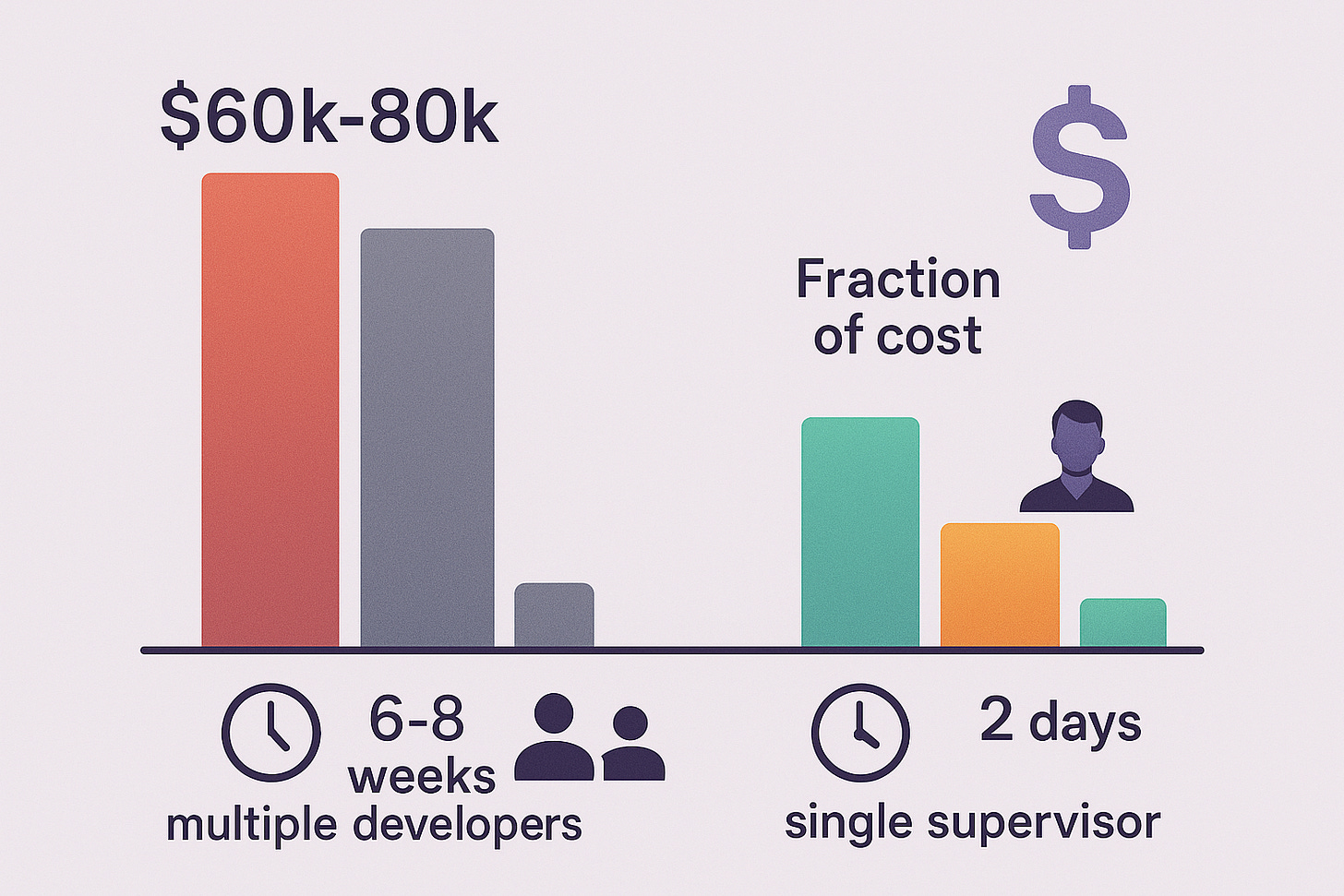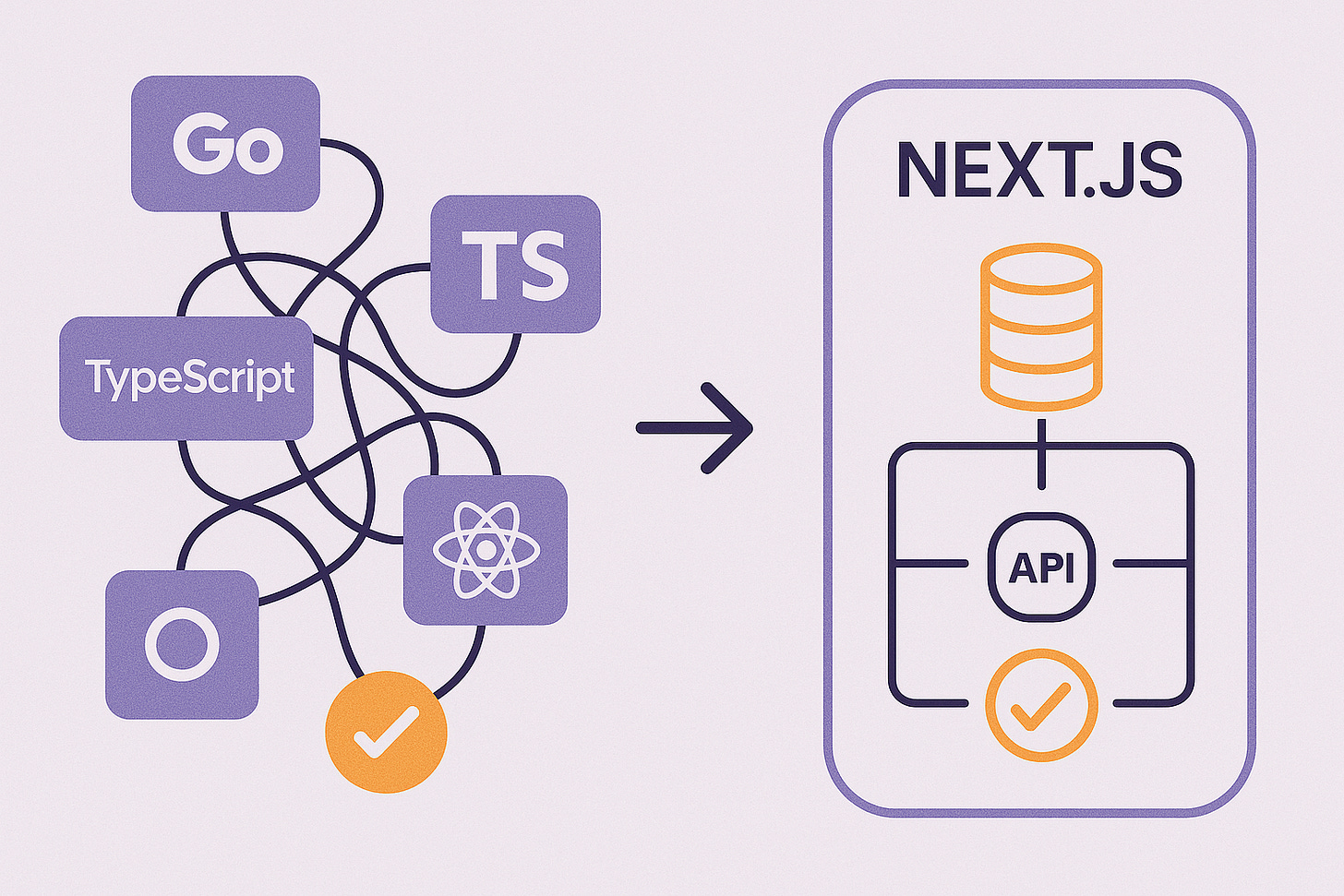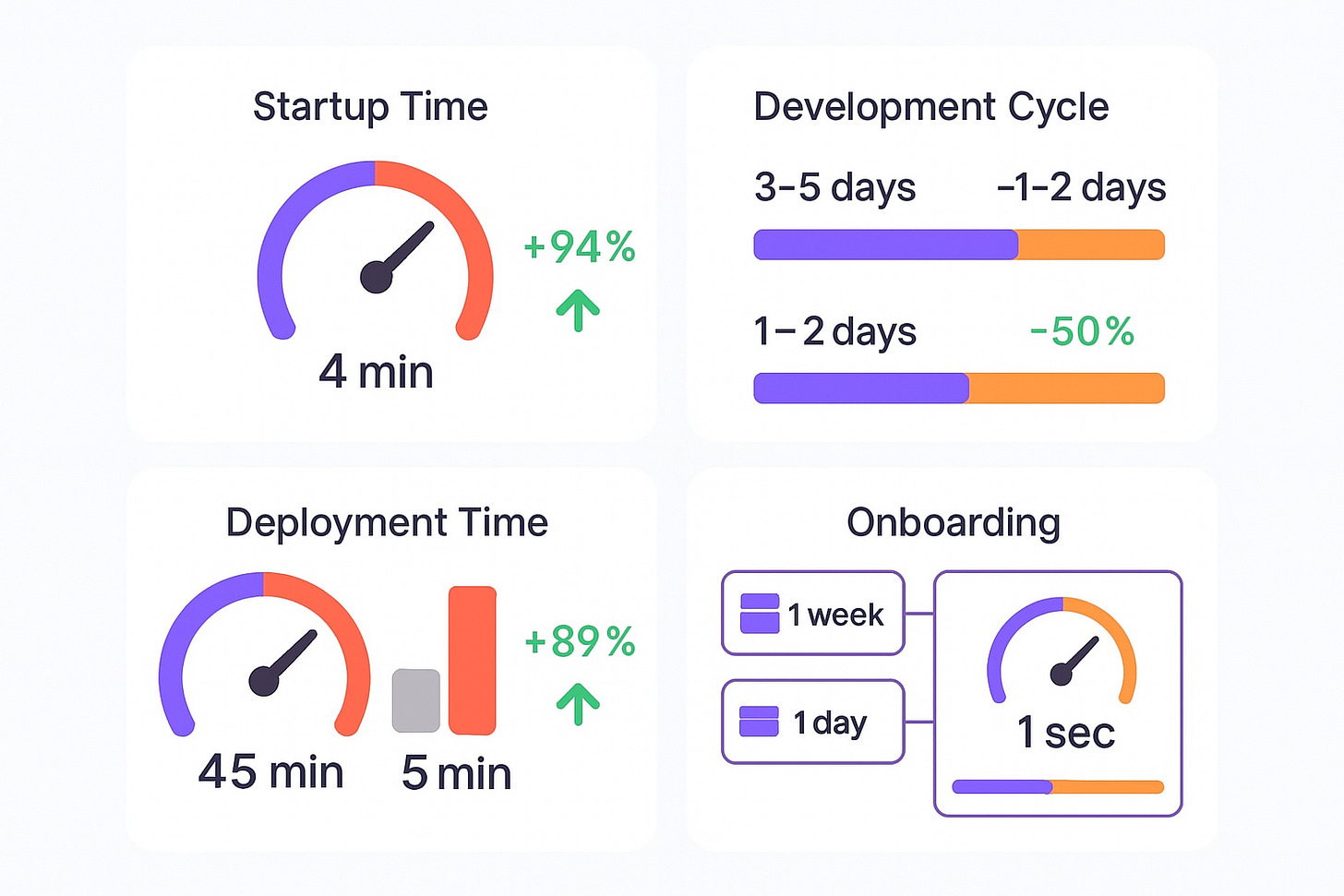The New Economics of Re-platforming
What a 2-Day Migration Taught Me About Agentic Re-Development ROI
I just finished the fastest platform migration of my career. Two development days. Five repositories consolidated into one. A complex Go/TypeScript/React architecture replaced with a unified Next.js application. 95% feature parity maintained.
These numbers should challenge how we think about replatforming economics.
The Over-Engineering Tax
Let me start with the problem that prompted this migration. I inherited a system that exemplified what happens when good engineers make reasonable decisions that compound into architectural debt. This wasn't about poor choices—these were competent engineers who made decisions based on what they were good at and the facts on the ground at the time:
Five repositories requiring cross-team coordination for simple features
Four-minute local environment startup (our internal target: 30 seconds)
Three different technology stacks (Go, TypeScript, React)
Zero automated testing across 50,000+ lines of code
Complex authentication setup requiring specialized Keycloak knowledge
45-minute deployments with high rollback risk
This wasn't bad engineering. Each decision made sense in context. But the accumulated complexity was killing development velocity. What's changed isn't the quality of those original decisions—it's how quickly we can rethink architectural choices with AI assistance.
And here's something worth considering: production-quality AI-friendly platforms like Python and TypeScript may be coming into their own precisely because of this velocity. When you can migrate in days instead of months, platform choices become more about AI tooling support than legacy constraints.
The "over-engineering tax" was real and measurable. Features that should take 1-2 days were taking 3-5 days. New developers needed a week to get productive instead of one day.
Traditional Migration Math vs. Reality
When I outlined this migration using traditional approaches, the math looked daunting:
Traditional Estimate:
Timeline: 6-8 weeks with 3-4 developers
Total hours: ~400 developer hours
Cost: $60,000-80,000 at market rates
Risk: High (complex coordination, extended transition period)
These numbers explain why most architectural debt never gets addressed. The cure seems worse than the disease.
But AI-assisted development has fundamentally changed migration economics. Here's how it played out using Claude MPM:
AI-Assisted Reality:
Timeline: 2 development days with 1 developer (me! really a 'supervisor') + Claude Code
Total hours: 16 hours of focused time, mostly AI time. Does require a Claude Max account and assumes Anthropic is stable.
Cost: Whatever your fractional CTO or head of engineering costs for a week (much less, even for me, than $60k)
Risk: Low (incremental approach with instant rollback capability)
That's a 95% reduction in time and cost with lower risk (an actual case of the - no longer - mythical 20x productivity gain!)
The Claude Code Sessions: Orchestrated Complexity
The migration happened across eight intensive Claude Code sessions. What struck me wasn't just the speed, but the capability to coordinate complex, multi-file transformations:
Session Breakdown:
Architecture analysis: 4 hours understanding existing patterns
Core API migration: 8 hours coordinating database, routes, and types
Frontend consolidation: 6 hours migrating and unifying React components
Testing infrastructure: 4 hours generating comprehensive test suites
Performance optimization: 3 hours fine-tuning and documentation
Each session handled 50+ file operations—creating API routes while generating TypeScript types, implementing database schemas while writing corresponding tests, migrating React components while updating their imports across the codebase.
This level of coordination typically requires careful human planning and sequential execution. Claude MPM handled it systematically, maintaining consistency across the entire stack.
But this wasn't just migration—it was rebuilding. We inferred the database queries from the existing Go APIs and database schema, then added an ORM for enhanced database flexibility. The AI essentially reverse-engineered the business logic from implementation and rebuilt it in a more maintainable form.
Quantifying the Transformation
The results were immediately measurable:
Development Velocity:
Local startup: 4 minutes → 15 seconds (93% improvement)
Feature development cycle: 3-5 days → 1-2 days (60% faster)
Deployment time: 45 minutes → 5 minutes (89% improvement)
New developer onboarding: 1 week → 1 day (85% improvement)
Code Quality:
Repositories: 5 → 1 (80% complexity reduction)
Programming languages: 3 → 1 (unified TypeScript)
Test coverage: 0% → 66% (246 comprehensive tests)
Documentation: Scattered → centralized
Architecture Simplification:
Backend services: 3 → Next.js API routes
Authentication: Complex custom → managed solution
Databases: Multi-service → single ORM
Frontend: 2 React apps → unified Next.js
The Hidden Economics of Platform Debt
What this migration revealed is that we've been calculating re-platforming ROI wrong. We typically compare migration cost against current development cost. But we should be comparing against the compounding cost of complexity.
The real economic equation:
Migration Cost vs. (Current Inefficiency × Time × Team Size × Opportunity Cost)
In this case:
Current inefficiency: 60% slower development, 75% longer onboarding
Team size: 3 developers affected
Time horizon: 2+ years of continued development
Opportunity cost: Features not built due to velocity constraints
When you run those numbers, even a traditional 8-week migration would pay for itself within 6 months. The 2-day AI-assisted migration paid for itself immediately.
Technology Choices That Amplify Returns
The migration success wasn't just about speed—it was about strategic technology choices that compound benefits over time:
Next.js 15 benefits:
App Router providing modern React patterns
API Routes eliminating separate backend services
Built-in optimization for performance and developer experience
TypeScript integration enabling end-to-end type safety
Modern authentication platform:
PII compliance built-in rather than custom implementation
Professional-grade security without infrastructure overhead
Developer-friendly SDK reducing integration complexity
Contemporary ORM:
Compile-time query validation catching errors before runtime
Optimized performance with minimal configuration
Intuitive schema management for future changes
These weren't just technical upgrades—they were investments in long-term development velocity.
What This Means for Replatforming Strategy
This experience suggests three shifts in how we should think about platform evolution:
1. AI Changes Migration Economics for Certain Projects
The traditional cost-benefit analysis for replatforming assumed human-scale development timelines. AI-assisted development can compress these timelines by 90%+ while maintaining quality through comprehensive testing and type safety—at least for mid-size SaaS stacks like this one.
This means architectural improvements that were previously economically questionable become worth considering.
2. Technical Debt Compounds Faster Than Expected
The velocity impact of architectural complexity rises faster than linearly. Each additional service, language, or deployment step creates coordination overhead that affects every future feature.
The "over-engineering tax" grows over time, making migration more valuable the longer you wait. But AI assistance makes migration faster with smaller, less divergent codebases.
3. Modern Platforms Provide Architectural Leverage
Technologies like Next.js, contemporary ORMs, and managed authentication platforms work well with AI-assisted development.
Next.js 15 benefits in practice:
App Router eliminated our separate backend services entirely
Built-in optimization reduced our infrastructure complexity
TypeScript integration caught errors that would have required debugging cycles
Modern authentication platform results:
Replaced 2,000 lines of custom Keycloak integration with 200 lines of SDK calls
Built-in PII compliance eliminated our compliance review cycle
Reduced authentication-related support tickets to zero
The combination of AI orchestration with well-designed platforms creates productivity improvements that neither could achieve alone.
The New Replatforming Framework
Based on this experience, here's how I now evaluate replatforming opportunities—with important caveats about context:
Context Recognition: This was a migration with rebuilding in a startup environment with a growing but small user base. Clearly, this isn't the same as working with a true legacy codebase or a very active production system. But the economics are so favorable that if I were a CTO, I'd be looking for opportunities to apply this model anywhere I could find them.
The Real Point About AI Productivity: The massive productivity gains people talk about with AI aren't an even x% across all use cases. They're a consistent 10-30% in rote tasks and workflow, and a massive 10-20x in cases like this. The key is knowing how to look for those opportunities.
Immediate Action Indicators:
Multiple repositories requiring coordination for simple features
Mix of programming languages or frameworks without clear benefit
Local development environment taking >60 seconds to start
Feature development taking 2x longer than similar organizations
New developer onboarding taking >3 days
Economic Calculation:
Estimate current velocity tax: (slower development % × team size × feature frequency)
Calculate AI-assisted migration cost: (2-5 days × senior developer rate)
Compare against 6-month continued inefficiency cost
Factor in opportunity cost of delayed features
Success Requirements:
Senior developer with migration architecture experience
Modern target platform with good AI tooling support (Next.js, Python/FastAPI, etc.)
Comprehensive test strategy during migration
Incremental rollout capability with instant rollback
Lessons for Engineering Leaders
The economics of replatforming have fundamentally shifted. What used to require months of careful planning and team coordination can now be accomplished in days with the right approach.
But this isn't about AI replacing human judgment—it's about AI amplifying architectural expertise. The migration succeeded because Claude MPM handled the mechanical complexity while I focused on strategic decisions and quality gates.
Here's what's particularly interesting: the engineering team responsible for maintaining the original codebase signed off on the AI-generated work. They'll be maintaining and extending it using AI assistive tools like Augment Code (or Cursor, or Windsurf). This suggests we're seeing the emergence of fast POCs as a legitimate architectural strategy.
For organizations carrying architectural debt, the question isn't whether you can afford to replatform. With AI assistance reducing cost and risk by 90%, the real question is whether you can afford not to.
The real lesson: meaningful productivity gains come from selecting the right projects and using orchestrated agent tools. When you find those 10-20x opportunities, the economics reshape everything.
This migration was completed using Claude Code with Next.js 15, TypeScript, and modern development practices. The methodology is documented and replicable for similar architectural transformations.






